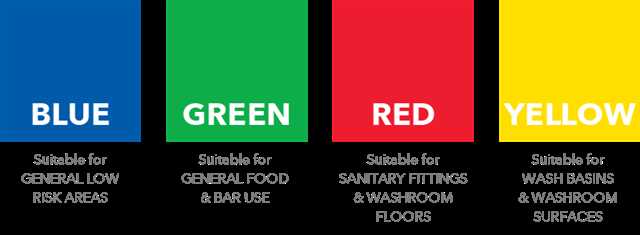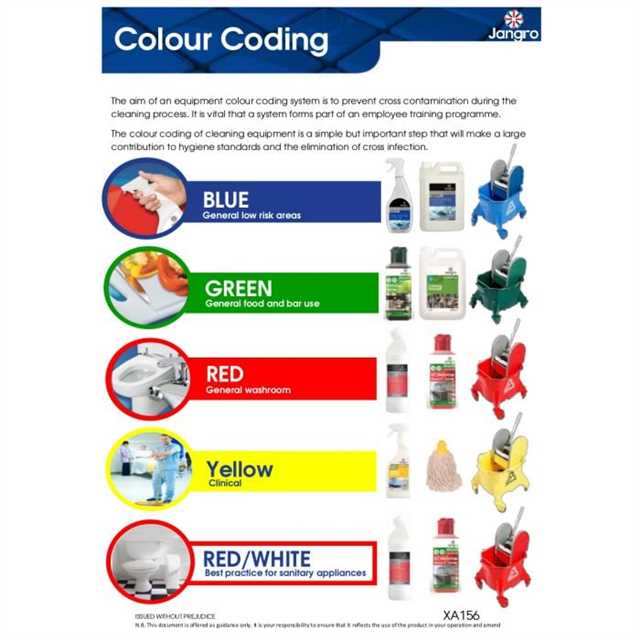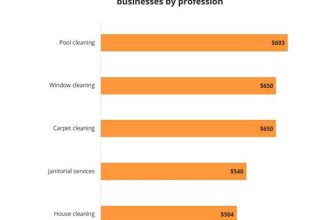
Have you ever wondered why the NHS uses colour coding systems for cleaning? The answer is simple – it is because colour coding of cleaning equipment in hospitals is extremely important.
In what area would you use red colour coded cleaning equipment? Well, red is commonly used in high-risk areas such as toilets and washroom facilities. By using red colour coded cleaning equipment, it ensures that the cleaning tools used in these areas are not used in any other parts of the hospital. This helps to prevent the spread of bacteria and cross-contamination.
On the other hand, what colour mop would you use for the kitchen? In the kitchen area, blue colour coded cleaning equipment is typically used. This is because blue is associated with food preparation areas. By using blue colour coded cleaning equipment, it helps to maintain hygiene and prevent any contamination that could occur from using the same cleaning tools in different areas of the hospital.
Overall, colour coding systems for cleaning are essential in maintaining cleanliness and preventing the spread of germs and infections within a hospital environment. By implementing colour coding, it ensures that the right cleaning equipment is used in the right areas, minimizing the risk of cross-contamination and promoting a safer and healthier environment.
Remember, when it comes to cleaning, it’s not just about getting the job done. It’s about doing it right, and colour coding is an important part of that process.
So, the next time you see colour coded cleaning equipment in a hospital, remember the benefits it brings and the importance of using the right tools in the right areas.
- Importance of Colour Coding in Cleaning
- In what area would you use blue colour coded cleaning equipment?
- What colour mop for kitchen?
- Why is colour coding important in the NHS?
- What are the benefits of colour coding systems in cleaning?
- Colour Coding Cleaning Systems for NHS
- Why Colour Coding?
- BICS Colour Coding System
- Implement Colour Coding Cleaning Systems for NHS
- BICS Color Code for Cleaning
- What is BICS?
- Why is colour coding important in cleaning?
- What colour mop should I use for the kitchen?
- What areas would you use red colour coded cleaning equipment?
- In what area would you use blue colour coded cleaning equipment?
- What about the NHS?
- What are the benefits of using colour-coded cleaning systems?
- Colour coding of cleaning equipment in hospitals
Importance of Colour Coding in Cleaning
Colour coding of cleaning equipment is an important system used in various industries, particularly in hospitals and healthcare environments. The use of different colours helps prevent cross-contamination and ensures that cleaning tasks are carried out efficiently and effectively.
In what area would you use blue colour coded cleaning equipment?
Blue colour coded cleaning equipment is typically used in non-clinical areas such as offices, classrooms, and general public spaces. This helps to differentiate these areas from high-risk or clinical areas.
What colour mop for kitchen?
In a kitchen setting, it is recommended to use a red colour coded mop. This ensures that the mop is only used in the kitchen and reduces the risk of spreading contaminants to other areas.
Why is colour coding important in the NHS?
The National Health Service (NHS) recognizes the importance of colour coding in cleaning as it helps minimize the spread of infections and ensures a safe and hygienic environment for patients, staff, and visitors. The use of colour coded cleaning equipment is part of the British Institute of Cleaning Science (BICSc) code of practice.
What are the benefits of colour coding systems in cleaning?
Colour coding systems provide several benefits, such as:
- Preventing cross-contamination
- Improving cleaning efficiency
- Enhancing hygiene standards
- Reducing the risk of infection
- Facilitating easy identification of cleaning equipment in different areas
By implementing colour coding systems, organizations can ensure that cleaning processes are carried out effectively, promoting a safer and healthier environment for everyone.
Colour Coding Cleaning Systems for NHS
Colour coding is important in cleaning, especially in environments where hygiene and safety are a top priority, such as the NHS. By using colour-coded cleaning equipment, it becomes easier to prevent cross-contamination and ensure that the right tools are used in the right areas.
Why Colour Coding?

Colour coding allows for easy identification and differentiation of cleaning tools based on their designated area of use. This practice helps to maintain a higher level of hygiene and reduces the risk of spreading harmful bacteria or viruses.
In the NHS, where maintaining a clean and sterile environment is essential, colour coding plays a crucial role. It ensures that cleaning equipment is not mistakenly mixed up or used in inappropriate areas, increasing the effectiveness of the cleaning process.
BICS Colour Coding System
The British Institute of Cleaning Science (BICSc) has developed a widely recognized colour coding system for cleaning. Here is a breakdown of the colours and their respective areas:
| Colour | Area |
|---|---|
| Blue | General Cleaning |
| Red | Sanitary Appliances and Washroom Floors |
| Green | Kitchens and Food Preparation Areas |
| Yellow | Isolation Units and Infectious Areas |
| White | Operating Theatres and Clinical Areas |
By adhering to the BICSc colour coding system, cleaning staff in the NHS can easily identify the appropriate tools to use in specific areas, reducing the risk of contamination and promoting a safer and cleaner environment.
When it comes to choosing a mop for the kitchen, it is recommended to use a blue colour-coded mop to maintain hygiene standards and prevent cross-contamination.
Implement Colour Coding Cleaning Systems for NHS
Implementing colour coding cleaning systems in the NHS is essential for providing a safe and hygienic environment for patients, staff, and visitors. By using the BICSc colour coding system, you can ensure that the right cleaning equipment is used in the right areas, minimizing the risk of infections and promoting overall cleanliness.
BICS Color Code for Cleaning
What is BICS?
BICS stands for British Institute of Cleaning Science. It is a professional organization that provides training and certification in cleaning and hygiene practices.
Why is colour coding important in cleaning?
Colour coding is an important system used in cleaning to prevent cross-contamination. By assigning specific colours to different areas or cleaning tasks, it helps to ensure that cleaning equipment is used only in their designated areas.
What colour mop should I use for the kitchen?
In the BICS color code system, green is typically used for cleaning the kitchen. This is to avoid contaminating other areas of the facility with food particles and pathogens that may be present in the kitchen.
What areas would you use red colour coded cleaning equipment?
Red is usually used for high-risk areas that require extra attention to hygiene, such as toilets and bathroom areas.
In what area would you use blue colour coded cleaning equipment?
Blue is commonly used in areas where general cleaning is needed, such as offices, reception areas, and hallways.
What about the NHS?
The colour coding system is also used in the National Health Service (NHS) in the UK. It helps to prevent the transmission of infections within healthcare settings by ensuring that cleaning equipment is used appropriately.
What are the benefits of using colour-coded cleaning systems?
- Reduced risk of cross-contamination
- Improved hygiene standards
- Easier identification of cleaning equipment for specific areas
- Enhanced organization and efficiency in cleaning processes
- Compliance with industry standards and regulations
- Increased safety for cleaning staff and facility users
Colour coding of cleaning equipment in hospitals
Hospitals and healthcare facilities often have strict protocols in place to prevent the spread of infections. Colour coding of cleaning equipment plays a crucial role in maintaining a clean and safe environment for patients and staff.








